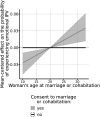Determinants of Emotional Intimate Partner Violence against Women and Girls with Children in Mexican Households: An Ecological Framework
- PMID: 35135364
- PMCID: PMC9679571
- DOI: 10.1177/08862605211072179
Determinants of Emotional Intimate Partner Violence against Women and Girls with Children in Mexican Households: An Ecological Framework
Abstract
The purpose of this paper is to identify the risk factors for emotional intimate partner violence (IPV) against women and girls with children in Mexico from an ecological perspective. To that end, we generate a dataset with 35,004 observations and 42 covariates, to which we apply an additive probit model estimated with a boosting algorithm to overcome high-dimensionality and simultaneously perform variable selection and model choice. The dataset integrates 10 information sources, allowing us to properly characterize the four levels of the ecological approach, which is the first contribution of this paper. In addition, there are three key contributions. First, we identify a number of factors significantly linked to emotional IPV against women with children: age, age at sexual initiation, age at marriage (or cohabitation), autonomy regarding professional issues, social support networks, division of housework, the community's Gini index, women's economic participation in the municipality, and the prevalence of crime against males in the region. Second, we discuss some risk factors whose effects have not been examined or have been underexplored for Mexico; these include women's decision-making autonomy, social support networks, distribution of housework, the community's economic inequality, and criminality. Third, we identify specific risk subgroups that are generally overlooked: women who had their first sexual intercourse during childhood and women who got married (or moved in together with a partner) late in life. The main results suggest that strategies aiming to promote women's social and economic empowerment and reduce criminality should also incorporate a gender component regarding emotional violence against women with children in the context of intimate relationships.
Conflict of interest statement
The author(s) declared no potential conflicts of interest with respect to the research, authorship, and/or publication of this article.
Figures




Similar articles
-
Intimate partner violence against married and cohabiting women in sub-Saharan Africa: does sexual autonomy matter?Reprod Health. 2022 Mar 28;19(1):79. doi: 10.1186/s12978-022-01382-1. Reprod Health. 2022. PMID: 35346246 Free PMC article.
-
Associations Between Women's Economic and Social Empowerment and Intimate Partner Violence: Findings From a Microfinance Plus Program in Rural North West Province, South Africa.J Interpers Violence. 2021 Aug;36(15-16):7747-7775. doi: 10.1177/0886260519836952. Epub 2019 Mar 27. J Interpers Violence. 2021. PMID: 30913954 Free PMC article.
-
Effectiveness of a culturally appropriate intervention to prevent intimate partner violence and HIV transmission among men, women, and couples in rural Ethiopia: Findings from a cluster-randomized controlled trial.PLoS Med. 2020 Aug 18;17(8):e1003274. doi: 10.1371/journal.pmed.1003274. eCollection 2020 Aug. PLoS Med. 2020. PMID: 32810146 Free PMC article. Clinical Trial.
-
The Effect of Female Economic Empowerment Interventions on the Risk of Intimate Partner Violence: A Systematic Review and Meta-Analysis.Trauma Violence Abuse. 2022 Jul;23(3):810-826. doi: 10.1177/1524838020976088. Epub 2020 Dec 8. Trauma Violence Abuse. 2022. PMID: 33287669
-
Women economic empowerment via cash transfer and microcredit programs is enough to decrease intimate partner violence? Evidence from a systematic review.Cad Saude Publica. 2019 Sep 9;35(9):e00174818. doi: 10.1590/0102-311X00174818. Cad Saude Publica. 2019. PMID: 31508698
Cited by
-
How does empowering men affect intimate partner violence? Evidence from Bangladesh.SSM Popul Health. 2024 Mar 16;26:101656. doi: 10.1016/j.ssmph.2024.101656. eCollection 2024 Jun. SSM Popul Health. 2024. PMID: 38544696 Free PMC article.
-
Verbal and psychological violence against women in Turkey and its determinants.PLoS One. 2022 Oct 10;17(10):e0275950. doi: 10.1371/journal.pone.0275950. eCollection 2022. PLoS One. 2022. PMID: 36215284 Free PMC article.
References
-
- Abramsky T., Lees S., Stöckl H., Harvey S., Kapinga I., Ranganathan M., Mshana G., Kapiga S. (2019). Women's income and risk of intimate partner violence: Secondary findings from the MAISHA cluster randomised trial in North-Western Tanzania. BMC Public Health, 19(1), 1108. 10.1186/s12889-019-7454-1 - DOI - PMC - PubMed
-
- Ackerson L. K., Subramanian S. V. (2008). State gender inequality, Socioeconomic Status and Intimate Partner Violence (IPV) in India: A multilevel analysis. Australian Journal of Social Issues, 43(1), 81–102. 10.1002/j.1839-4655.2008.tb00091.x - DOI
-
- Avila-Burgos L., Valdez-Santiago R., Híjar M., Del Rio-Zolezzi A., Rojas-Martínez R., Medina-Solís C. E. (2009). Factors associated with severity of intimate partner abuse in Mexico: Results of the first National survey of violence against women. Canadian Journal of Public Health, 100(6), 436–441. http://www.jstor.org/stable/41995320 - PMC - PubMed
Publication types
MeSH terms
LinkOut - more resources
Full Text Sources
Medical

